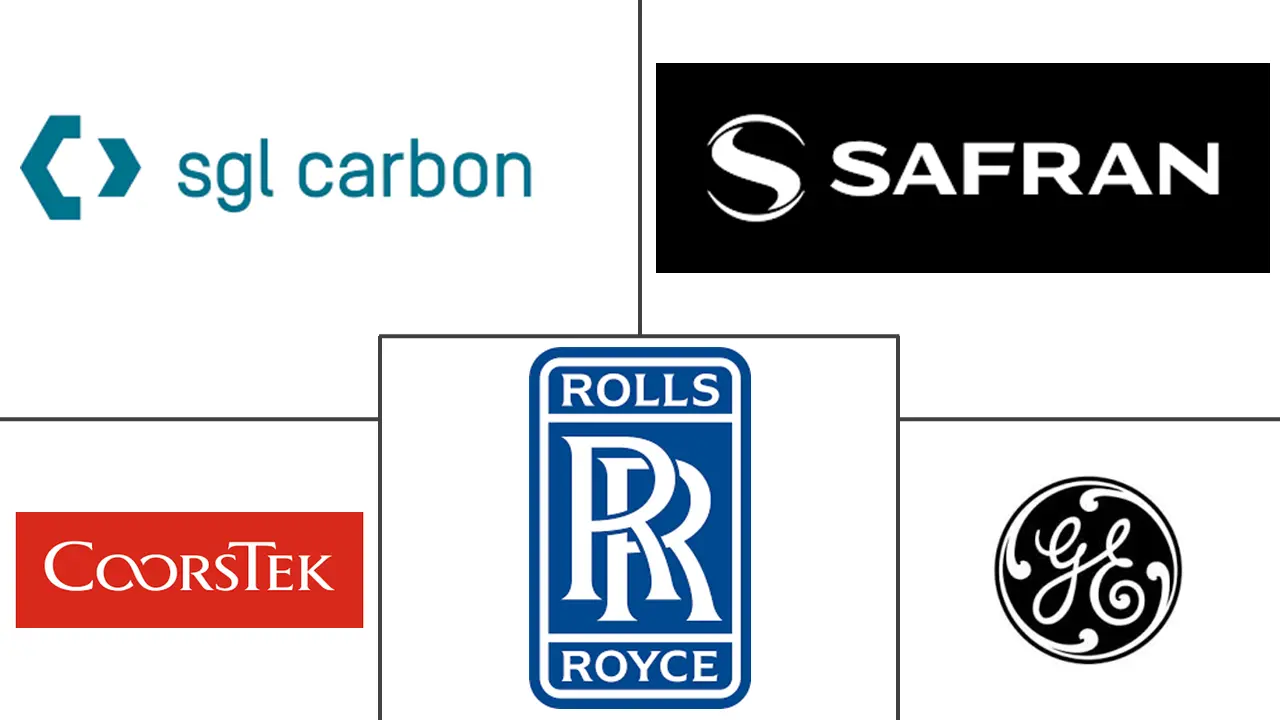Ceramic Matrix Composites Market Size and Share
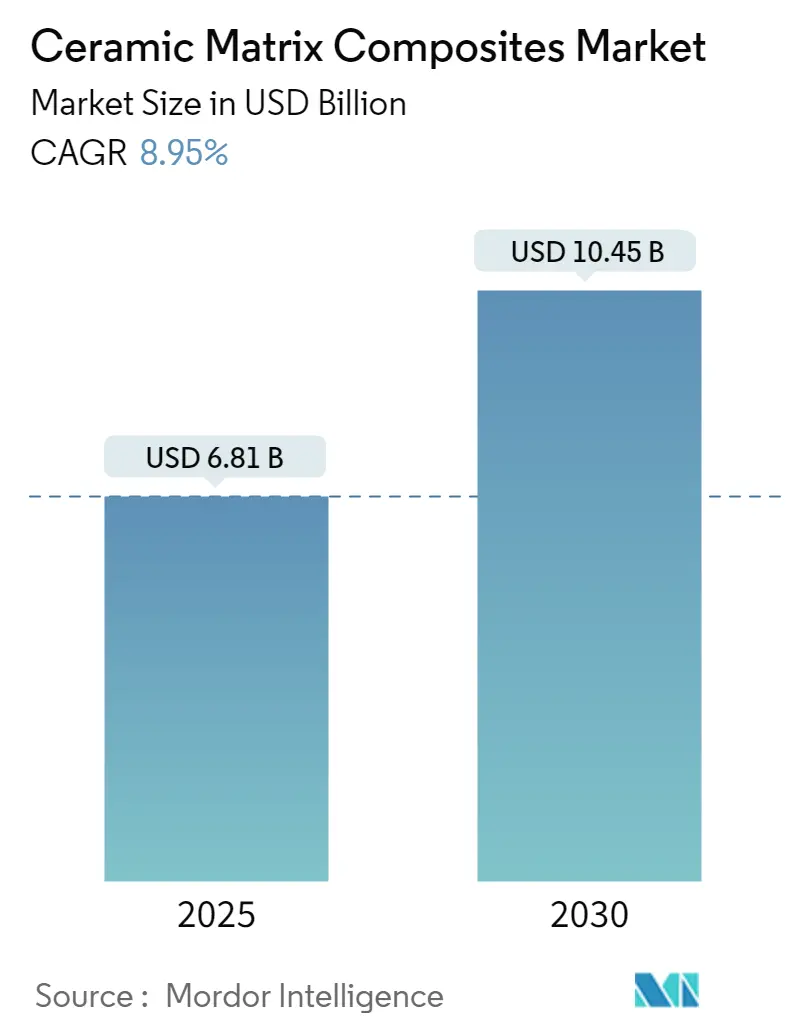
Ceramic Matrix Composites Market Analysis by Mordor Intelligence
The global ceramic matrix composites market is valued at USD 6.81 billion in 2025 and is forecast to reach USD 10.45 billion by 2030, registering an 8.95% CAGR through the period. Expansion rests on the material’s ability to combine the toughness of metals with the heat resistance of ceramics, a balance that unlocks performance gains for aerospace engines, hypersonic systems, and industrial gas turbines. Investment in lightweight propulsion, stricter fuel-burning standards, adoption of variable-fuel turbines, and the search for longer-life high-temperature parts shape the current demand outlook. Cost-down progress in automated fiber placement and reactive melt infiltration is compressing cycle times and closing the cost gap with nickel super-alloys, while government grants for advanced‐materials plants are de-risking capacity additions. A wider set of end users—from chemical processors to fusion-energy developers—now specify CMCs, reflecting a more diversified opportunity mix that supports long-term growth resilience.
Key Report Takeaways
- By product type, SiC/SiC composites led with 55.19% of ceramic matrix composites market share in 2024, and are expected to grow at the fastest CAGR of 11.05% through 2030.
- By end-user industry, aerospace accounted for 45.42% revenue in 2024; defense is the fastest segment, advancing at a 9.08% CAGR through 2030.
- By geography, North America captured 37.96% of the ceramic matrix composites market size in 2024, while Asia-Pacific is forecast to expand at a 10.84% CAGR.
Global Ceramic Matrix Composites Market Trends and Insights
Driver Impact Analysis
| Driver | (~) % Impact on CAGR | Geographic Relevance | Impact Timeline |
|---|---|---|---|
| Increasing defense-grade thermal barrier applications | +2.1% | Global, concentrated in North America & Europe | Medium term (2-4 years) |
| Lightweight vehicle platforms demand | +1.8% | Global, with APAC leading automotive adoption | Long term (≥ 4 years) |
| Growing renewable gas-turbine retrofits | +1.4% | Europe & North America, expanding to APAC | Medium term (2-4 years) |
| Hypersonic vehicle R&D acceleration | +1.2% | North America, Europe, China | Short term (≤ 2 years) |
| Increasing Application of Ceramic Matrix Composites in Defense Sector | +0.9% | Global, led by major defense spenders | Medium term (2-4 years) |
| Source: Mordor Intelligence | |||
Increasing Defense-Grade Thermal Barrier Applications
Defense agencies now treat thermal capability as a primary design filter. Hypersonic munitions programs in the United States require materials that remain structurally stable above 2,000 °C, a threshold that eliminates most super-alloys. Lockheed Martin’s test series highlights the need for CMCs in electronics ruggedization and aero-shell protection. The premium prices defense contractors accept for survivability accelerate early CMC qualification, generating learning curves that benefit other sectors. Carbon-fiber reinforced silicon carbide composites have demonstrated reusable performance after multiple high-heat cycles, an advantage that shifts life-cycle cost equations.
Lightweight Vehicle Platforms Demand
Electric and autonomous vehicle programs pursue aggressive mass-reduction targets because every kilogram saved improves driving range and cooling efficiency. Ceramic matrix composites weigh up to 65% less than nickel-based alloys yet retain functional strength at exhaust temperatures. Demonstration ceramic gas turbines in Japan reached thermal efficiencies above 40% while cutting component weight by double-digit percentages[3]M. Kohyama et al., “Advances in SiC Fiber Technology,” sciencedirect.com Source: CompositesWorld Editorial, “SCANCUT Project Cuts CMC Machining Time by 70%,” compositesworld.com . Automotive production volumes push suppliers toward near-net-shape processes such as automated fiber placement that convert hours-long layups into minute-level cycles.
Growing Renewable Gas-Turbine Retrofits
Variable-fuel turbines that balance solar and wind intermittency need hot-section parts capable of rapid load swings and higher firing temperatures. CMC vanes reduce cooling air bleed, translating to a 2–3 percentage point system efficiency gain. Oxide-oxide composites retain strength at 1,100 °C and can reach surface temperatures of 1,300 °C with coatings, making them attractive for combined-cycle plants in Europe’s flexible-grid mandate. The trend broadens the ceramic matrix composites market beyond aerospace, diversifying revenue streams.
Hypersonic Vehicle R&D Acceleration
Mach 5-plus flight tests produce skin temperatures above 1,500 °C and introduce steep thermal gradients. Stratolaunch’s Talon-A2 reusable demonstrator used CMCs for aero-shells that survived multiple sorties, validating performance and refurbishment economics. Ultra-high temperature CMCs based on carbon fiber and zirconium oxycarbide now approach 3,500 °C capability, positioning the material set for scramjet inlets and control surfaces. Government roadmaps identify CMC manufacturing capacity as a dual-use infrastructure priority, unlocking federal funds for pilot lines.
Restraint Impact Analysis
| Restraint | (~) % Impact on CAGR | Geographic Relevance | Impact Timeline |
|---|---|---|---|
| High production cost vs. super-alloys | -1.9% | Global, most acute in price-sensitive markets | Long term (≥ 4 years) |
| Complex multi-step manufacturing routes | -1.3% | Global, affecting scalability and quality consistency | Medium term (2-4 years) |
| Stricter fibre-dust emission norms | -0.8% | Europe & North America, expanding globally | Short term (≤ 2 years) |
| Source: Mordor Intelligence | |||
High Production Cost vs. Super-Alloys
CMC parts still cost 3–5 times more than comparable metallic parts due to high-temperature fiber draw and lengthy infiltration steps. The SCANCUT project cut machining time by 70% through novel milling paths, and similar automation breakthroughs are narrowing the gap. Total cost of ownership improves as CMC lifetimes lengthen, but initial acquisition price remains a hurdle for price-sensitive power and automotive users. GE’s USD 200 million Alabama facility targets cost parity at scale geaerospace.
Complex Multi-Step Manufacturing Routes
Chemical vapor and polymer infiltration require days of furnace time, constraining throughput and yield. Integrated with automated tape laying, reactive melt infiltration has proven cycle-time reductions while preserving density. Flash-assisted sintering now achieves 99% dense parts in under 10 minutes, hinting at production paradigms that rival traditional casting. Digital twins and AI-driven controls promise tighter process windows yet need capital and skills to deploy at factory scale.
Segment Analysis
By Product Type: SiC/SiC Dominance Drives Innovation
SiC/SiC composites held 55.19% ceramic matrix composites market share in 2024 and are projected to grow at an 11.05% CAGR to 2030. Integration of finer pitch fibers delivering strengths above 2 GPa has expanded their structural envelope. The ceramic matrix composites market size for SiC/SiC applications is forecast to rise sharply as new jet engine cores qualify shrouds, combustor liners, and nozzle extensions. Carbon/carbon systems maintain niches in rocket nozzles where oxidation can be controlled, and oxide/oxide grades gain traction in industrial heat exchangers that value inherent oxidation stability over peak temperature.
Process advances include nano-engineered interphases that mitigate fiber damage during thermal cycling. Mitsubishi Chemical Group’s carbon-fiber-based C/SiC, qualified for 1,500 °C exposure, shows how hybrid chemistries extend temperature ceilings for space vehicles[1]Mitsubishi Chemical Group, “High Heat-Resistant Ceramic Matrix Composite Using Pitch-Based Carbon Fibers,” mcgc.com. The additive deposition of SiC slurry onto woven preforms makes complex cooling passages not feasible with legacy layups. Such innovations maintain the lead of the SiC/SiC family and attract investment from turbine primes.
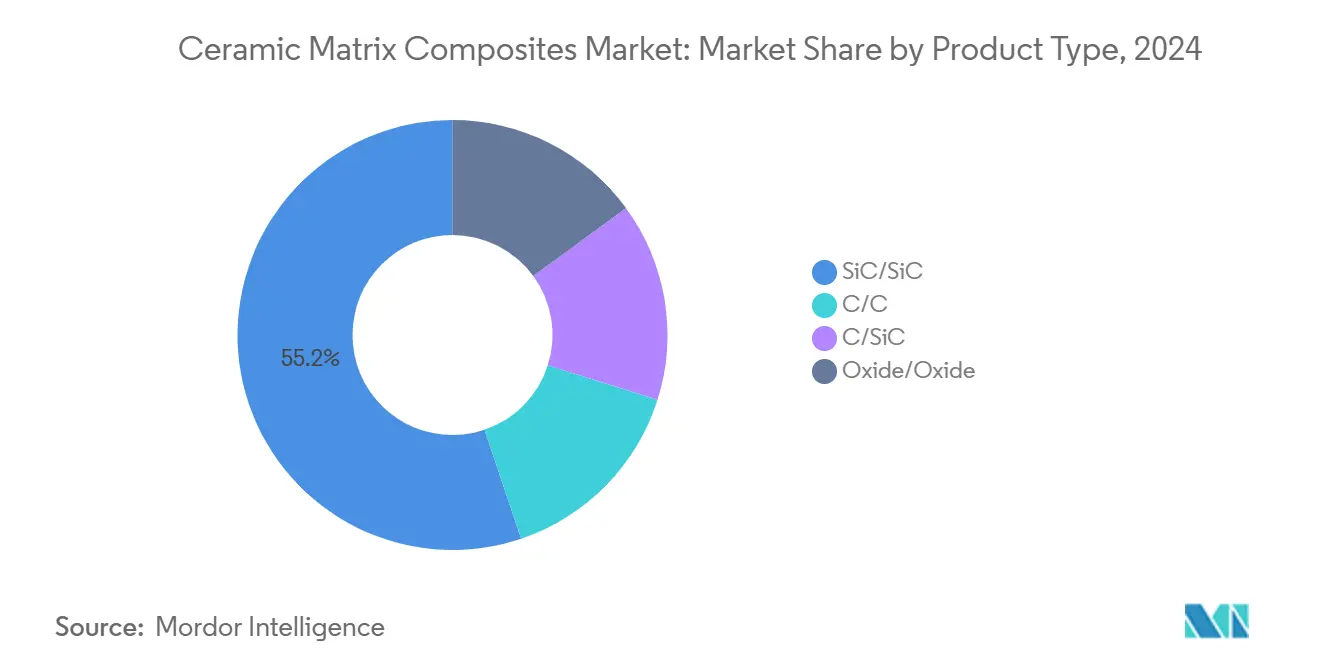
Note: Segment Share of all individual segments available upon report purchase
By End-User Industry: Aerospace Leadership Meets Defense Acceleration
The aerospace segment generated 45.42% revenue in 2024, benefiting from long-running qualification programs that placed CMC shrouds and nozzles into thousands of commercial engines. The ceramic matrix composites market size for aerospace is expected to expand steadily as new single-aisle platforms enter service with CMC-rich cores. Defense shows the quickest growth at a 9.08% CAGR, propelled by hypersonic glide vehicle and scramjet prototypes that demand ultra-high temperature bodies. The ceramic matrix composites market share of defense remains smaller but climbs each year as programs move from prototype to low-rate initial production.
Industrial gas turbines represent a mid-growth tier as utilities retrofit combined-cycle stations for frequent starts. Automotive volumes remain limited to demonstration exhausts and brake discs, yet the pivot to battery-electric cars makes high-temperature lightweight enclosures desirable for thermal modules. Electrical and electronics users tap the dielectric and thermal-spread qualities of oxide CMCs for power modules where silicon carbide chips operate hotter than legacy silicon parts.
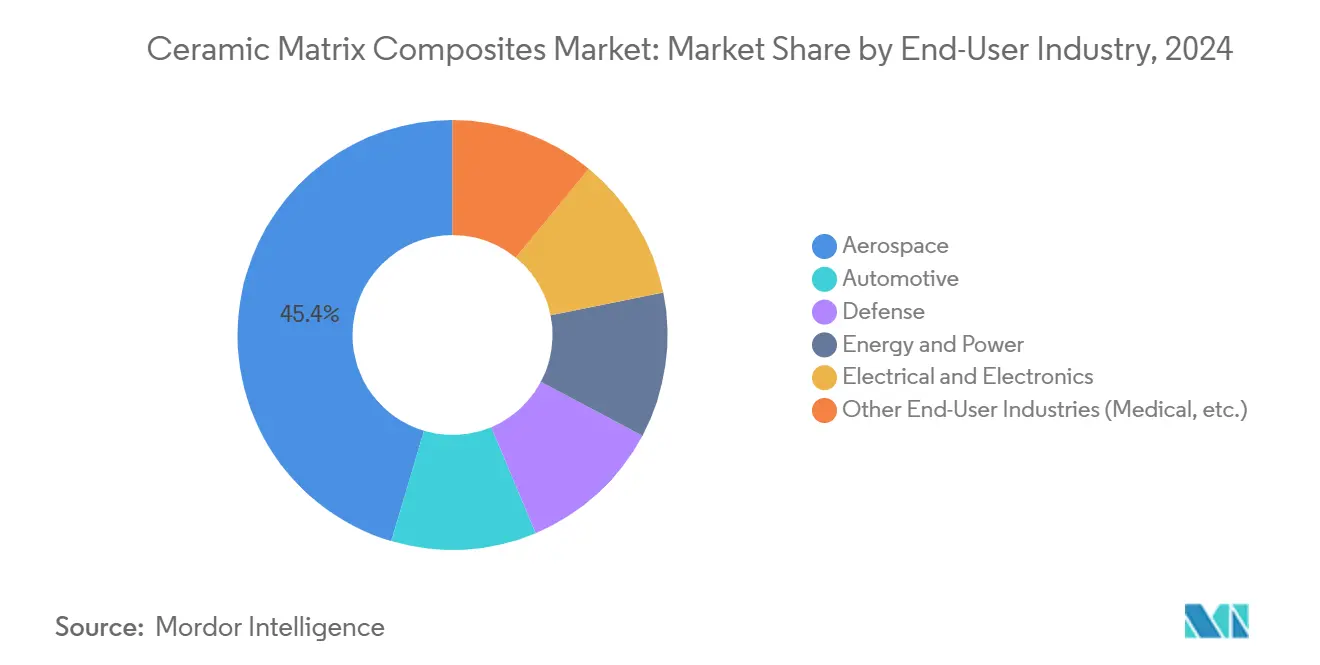
Note: Segment Share of all individual segments available upon report purchase
Geography Analysis
Due to dense aerospace and defense ecosystems, North America commanded 37.96% of the ceramic matrix composites market revenue in 2024. The region houses vertically integrated supply chains that span SiC fiber draw, component layup, machining, and engine assembly. Government initiatives like the Institute for Advanced Composites Manufacturing Innovation funnel grants toward pilot lines, underpinning local capacity. Rolls-Royce and GE place multi-year orders that smooth demand cycles and justify further plant expansions.
Asia-Pacific delivers the fastest 10.84% CAGR through 2030 as China and Japan escalate strategic materials programs. National plans seek supply independence for high-performance fibers, with milestone targets set for 2035[2]UK National Composites Centre, “Collaboration Developing Silicon Carbide Ceramic Matrix Composites for Fusion,” theengineer.co.uk. Automotive electrification also stimulates regional demand for lightweight, thermally resilient parts. Lower labor costs and proactive subsidies enable competitive export pricing, positioning the region as a significant consumer and global ceramic matrix composites market supplier.
Europe maintains a steady share through turbine retrofits that support renewable-heavy grids and through new aircraft engine demonstrators such as Rolls-Royce UltraFan. EU research networks pool public and private funds to mature oxide-oxide grades suitable for industrial furnaces, widening application scope. Strict emission regulations create a positive policy environment for efficiency-raising materials like CMCs, reinforcing European demand.
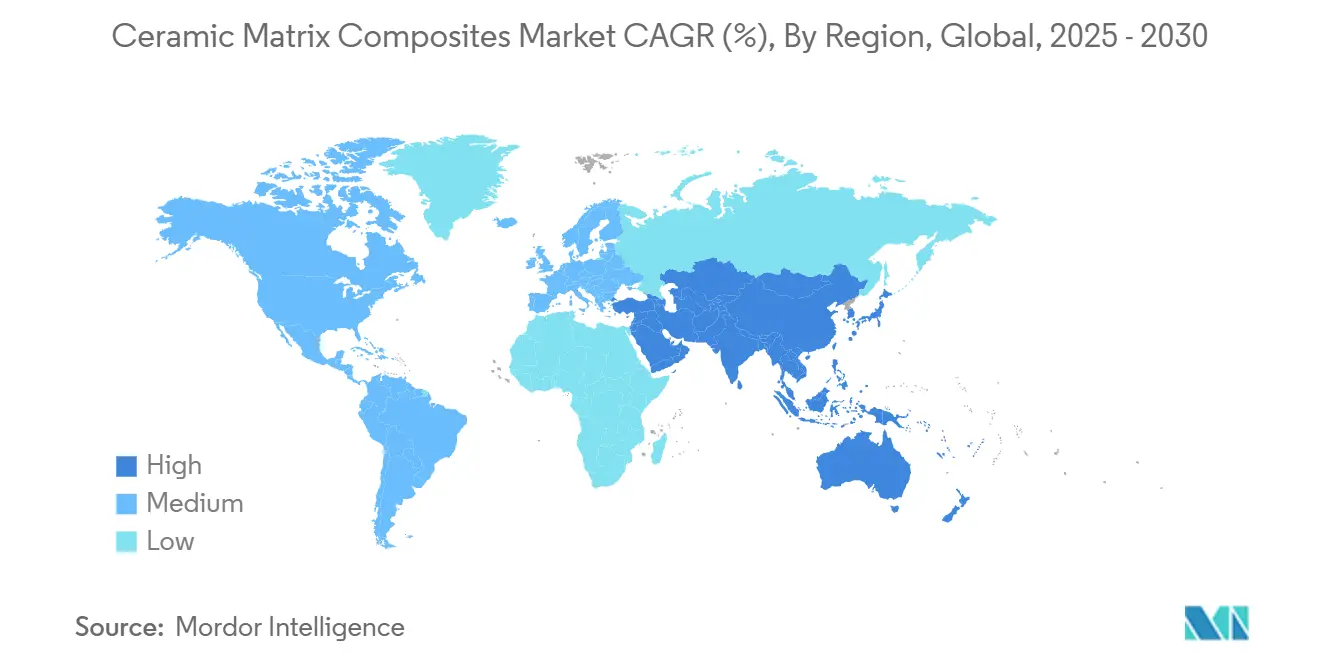
Competitive Landscape
The ceramic matrix composites market is highly fragmented, dominated by aerospace leaders such as General Electric Company, Rolls-Royce, and Safran, which employ proprietary fiber chemistries and infiltration processes. Their forward integration ensures component reliability and accelerates qualification cycles, creating significant entry barriers.
Smaller material specialists focus on industrial and fusion-energy sectors with unique performance requirements. Licensing additive manufacturing patents enables cost-effective production of complex parts, while collaborations like UKAEA’s work on fusion-grade silicon carbide/silicon carbide advance scalable solutions.
Ceramic Matrix Composites Industry Leaders
-
General Electric Company
-
Rolls-Royce
-
Safran
-
SGL Carbon
-
CoorsTek Inc.
- *Disclaimer: Major Players sorted in no particular order
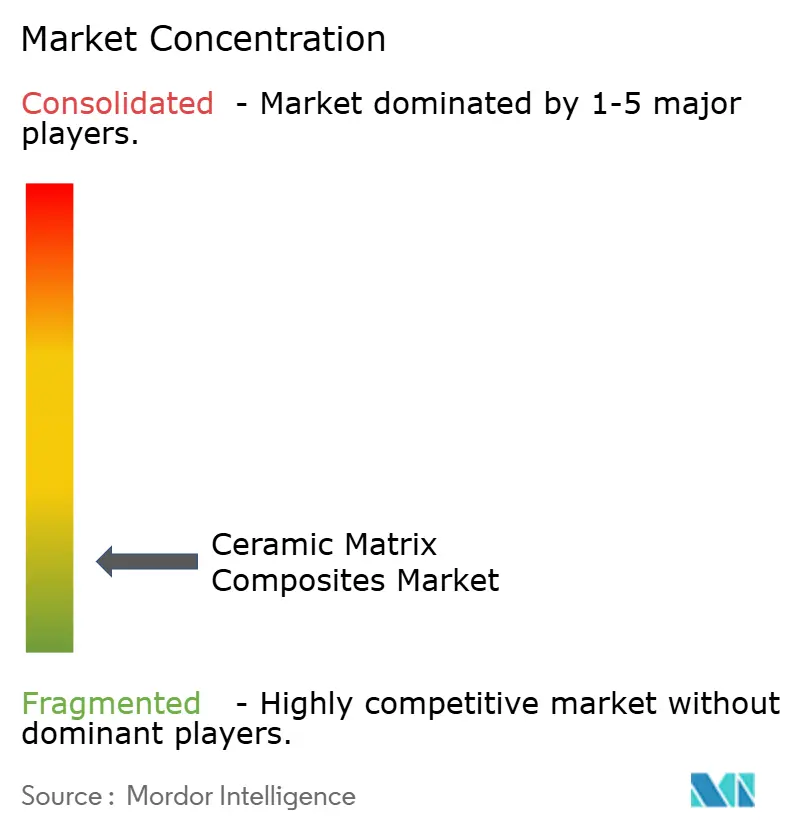
Recent Industry Developments
- February 2024: Mitsubishi Chemical Group Corporation developed a high heat-resistant ceramic matrix composite (CMC) using proprietary pitch-based carbon fibers, capable of withstanding temperatures up to 1,500 °C. The CMC, featuring an oxygen transmission barrier layer, retains strength after exposure to 1,500 °C for one hour and meets the Japan Aerospace Exploration Agency’s (JAXA) 1,600 °C for 800 seconds target. MCG Group aims to enhance this technology for reusable space transportation systems and space recovery platforms, expected by the early 2030s.
- April 2023: The National Composites Centre (NCC) and the UK Atomic Energy Authority (UKAEA) developed fusion-grade silicon carbide ceramic matrix composites under the HASTE-F programme, funded by the Royce Materials Challenge Accelerator Programme (MCAP). This initiative addresses engineering challenges in using silicon carbide composites (SiC/SiC) for fusion applications.
Research Methodology Framework and Report Scope
Market Definitions and Key Coverage
Our study defines the ceramic matrix composites market as the annual value of newly manufactured structural components in which ceramic fibers are embedded in a ceramic (oxide or non-oxide) matrix to boost toughness, thermal shock resistance, and strength for service above 1,200 deg C in aerospace engines, hypersonic systems, energy turbines, and select high-performance automotive parts.
Scope exclusion: prototype coupons, recycled fragments, and hybrid polymer-ceramic laminates are not counted.
Segmentation Overview
- By Product Type
- C/C
- C/SiC
- Oxide/Oxide
- SiC/SiC
- By End-user Industry
- Automotive
- Aerospace
- Defense
- Energy & Power
- Electrical & Electronics
- Other End-User Industries (Medical, etc.)
- By Geography
- Asia-Pacific
- China
- India
- Japan
- South Korea
- Malaysia
- Thailand
- Indonesia
- Vietnam
- Rest of Asia-Pacific
- North America
- United States
- Canada
- Mexico
- Europe
- Germany
- United Kingdom
- France
- Italy
- Spain
- Turkey
- Russia
- Nordic Countries
- Rest of Europe
- South America
- Brazil
- Argentina
- Colombia
- Rest of South America
- Middle East and Africa
- Saudi Arabia
- United Arab Emirates
- Qatar
- Egypt
- Nigeria
- South Africa
- Rest of Middle East and Africa
- Asia-Pacific
Detailed Research Methodology and Data Validation
Primary Research
Mordor analysts interviewed propulsion engineers, composite tooling specialists, and procurement leads across North America, Europe, and Asia-Pacific. Conversations clarified real contract lead times, scrap factors, and acceptable price premiums. Short online surveys with turbine OEM buyers helped fine-tune regional penetration rates and learning curve assumptions.
Desk Research
We began with publicly available program statistics from agencies such as NASA, the European Space Agency, the U.S. Department of Defense budget justifications, and customs trade codes for SiC fiber tow, which reveal production volumes and import values. Data on gas turbine shipments were compiled from the International Energy Agency and the Global Gas Turbine Association, while passenger jet deliveries were tracked through FAA and EASA registers. Company 10-Ks and investor decks were screened in D&B Hoovers, and news flows followed in Dow Jones Factiva to benchmark capacity additions and average selling prices. Material science insights were drawn from peer-reviewed journals (e.g., Journal of the American Ceramic Society) and patent trends sourced via Questel to map technology diffusion. These sources illustrate demand drivers, cost curves, and application shares; however, they are illustrative rather than exhaustive, as many other references supported validation.
Market-Sizing & Forecasting
A top-down construct starts with OEM output: civil jet engines, military propulsion units, and industrial turbines, which are then multiplied by average composite weight per unit and blended ASPs to build the 2025 demand pool. Selected bottom-up checks, supplier roll-ups for SiC/SiC shrouds and inlet cone channel contacts, calibrate totals. Key variables within the model include: 1. Annual narrow-body engine deliveries, 2. Defense hypersonic flight test counts, 3. Installed renewable gas turbine megawatts, 4. SiC fiber price index, 5. Oxide-oxide composite yield improvements, 6. Exchange rate movements for major producing nations.
A multivariate regression that links unit growth to aircraft production, turbine retrofit cycles, and defense R&D outlays produces the five-year forecast. Scenario analysis adjusts for step changes in manufacturing costs. Data gaps in bottom-up trails are infilled using normalized cost densities referenced from recent tenders.
Data Validation & Update Cycle
Outputs pass three analyst reviews, variance checks versus historical import trends, and a sanity screen against independent weight per engine norms before sign-off. The dataset refreshes every twelve months, with interim revisions triggered by material contract awards or plant shutdowns. A final sweep occurs just before client delivery.
Why Mordor's Ceramic Matrix Composites Baseline Commands Reliability
Published values often differ because each firm frames the market through distinct component lists, price bases, and refresh cadences.
Key gap drivers include whether uncured preforms are booked as final products, how aftermarket spares are treated, and the extent to which publishers adjust for aggressive defense backlog announcements.
Benchmark comparison
| Market Size | Anonymized source | Primary gap driver |
|---|---|---|
| USD 6.81 B (2025) | Mordor Intelligence | - |
| USD 12.76 B (2025) | Global Consultancy A | Counts uncured preforms and aggregates six-year defense backlog into single-year value |
| USD 8.78 B (2025) | Industry Journal B | Derives totals from mixed-year company filings without stripping inter-segment transfers |
The comparison shows that when the right scope, consistent ASP baselines, and up-to-date production volumes are applied, Mordor offers a balanced, defensible starting point that decision makers can trace directly to transparent variables and repeatable steps.
Key Questions Answered in the Report
What is the current value of the Ceramic Matrix Composites Market?
The market is worth USD 6.81 billion in 2025 and is forecast to grow to USD 10.45 billion by 2030.
Which segment leads the market by product type?
SiC/SiC composites command 55.19% ceramic matrix composites market share in 2024 and are growing fastest at an 11.05% CAGR.
Which region is expanding most rapidly?
Asia-Pacific is projected to register a 10.84% CAGR through 2030 due to industrialization and government support for advanced materials.
Why are CMCs critical for hypersonic vehicles?
They maintain structural strength above 2,000 °C, resist oxidation, and enable reusable designs required for hypersonic flight profiles.
What remains the biggest barrier to wider adoption?
Production cost remains 3–5 times higher than super-alloys, although new automated routes are narrowing the gap.
Page last updated on:
